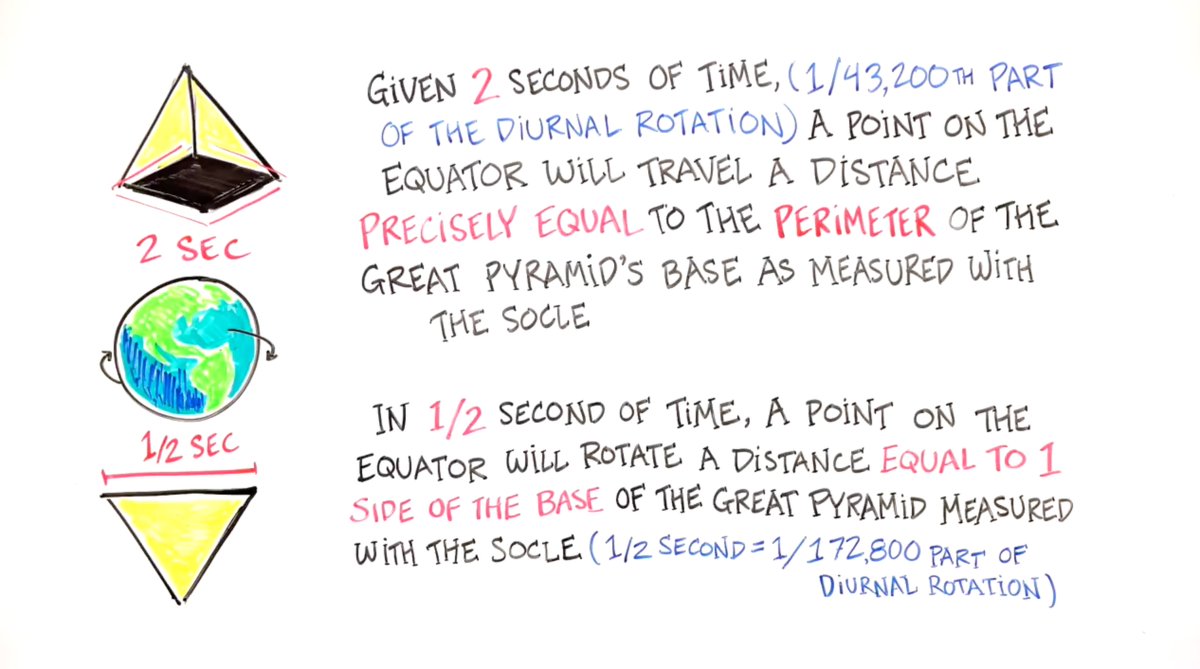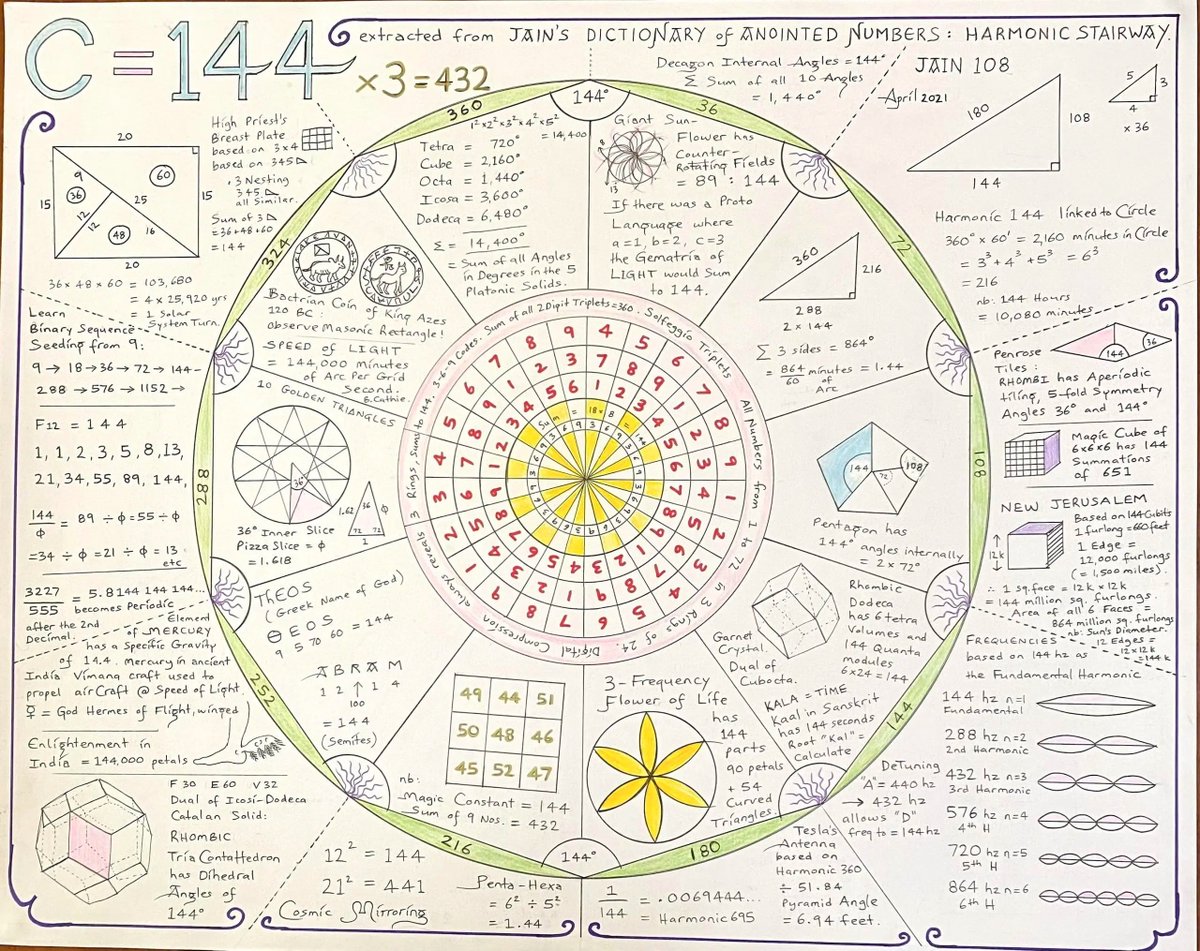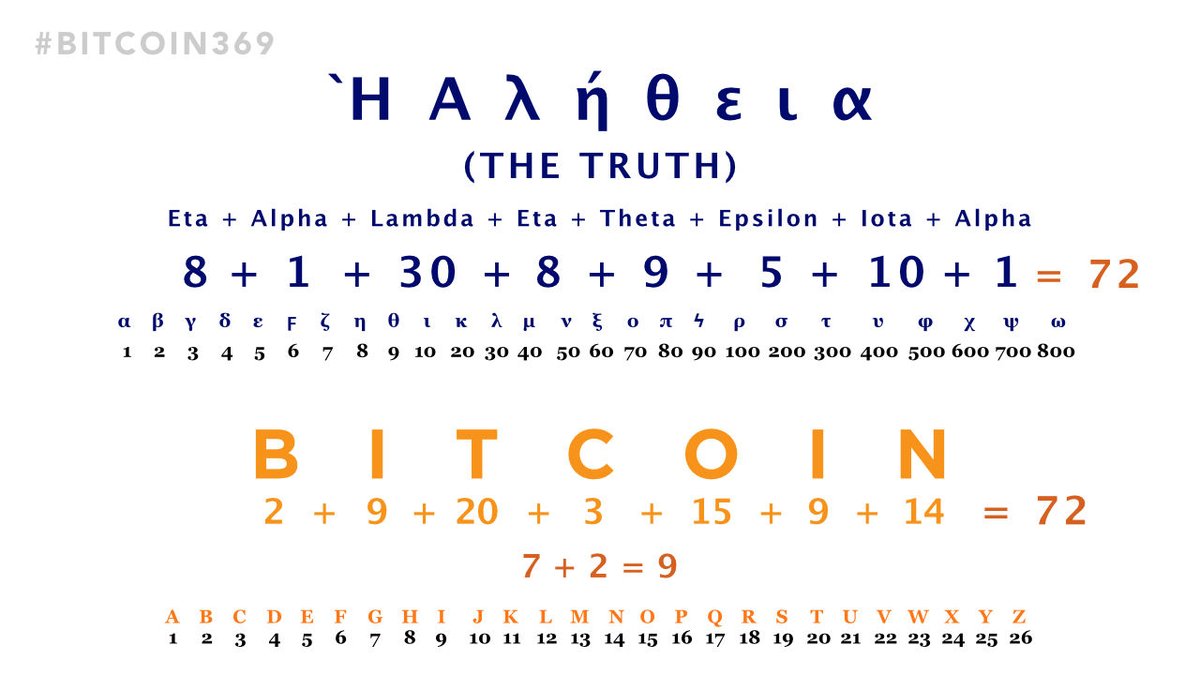If only you knew the magnificence of #Bitcoin then you would have a key to the universe. —Nikola Tesla
21 Million coins:
2 + 1 + 0 + 0 + 0 + 0 + 0 + 0 = 3
33 Halvings:
3 + 3 = 6
Difficulty adjusts every 2016 blocks:
2 + 0 + 1 + 6 = 9
21 Million coins:
2 + 1 + 0 + 0 + 0 + 0 + 0 + 0 = 3
33 Halvings:
3 + 3 = 6
Difficulty adjusts every 2016 blocks:
2 + 0 + 1 + 6 = 9

Tesla, like many others, believed the numbers 3, 6, 9 are part of the cosmic blueprint.
Omne trium perfectum (‘everything that comes in threes is perfect, or, every set of three is complete’).
medium.com/the-ascent/why…
Omne trium perfectum (‘everything that comes in threes is perfect, or, every set of three is complete’).
medium.com/the-ascent/why…
The numbers 3, 6, 9 are also found throughout the Great Pyramid of Giza
The numbers 3, 6, 9 are found throughout nature and throughout the universe.
In particular, the "Digital Root" of numbers found throughout nature often equal 3, 6 or 9.
For instance a circle is 360º
3 + 6 + 0 = 9
Divide it in half: 180º
1 + 8 + 0 = 9
And so on...
For instance a circle is 360º
3 + 6 + 0 = 9
Divide it in half: 180º
1 + 8 + 0 = 9
And so on...

Satoshi also programmed 3, 6, 9 throughout #Bitcoin as Digital Roots for...
• The first block after every halving
• The number of ₿ created each halving
• The number of ₿ created each day
• The number of ₿ left to mine after each halving
🤯
• The first block after every halving
• The number of ₿ created each halving
• The number of ₿ created each day
• The number of ₿ left to mine after each halving
🤯

The numeric secret to the universe—3, 6, 9—is encoded into many aspects of #Bitcoin.
This is yet another reason why people wonder if #Bitcoin is alien technology. tomerstrolight.medium.com/why-people-won…
This is yet another reason why people wonder if #Bitcoin is alien technology. tomerstrolight.medium.com/why-people-won…
Gematria is the practice of assigning a numerical value to a word according to an alphanumerical cipher. A single word can yield several values depending on the cipher which is used
The digital root for "Bitcoin" results in 3, 6, 9 for all major ciphers
"Bitcoin" = 72
7 + 2 = 9
The digital root for "Bitcoin" results in 3, 6, 9 for all major ciphers
"Bitcoin" = 72
7 + 2 = 9

“If you want to find the secrets of the universe, think in terms of energy, frequency and vibration.” ―Nikola Tesla
The numbers 3 6 9 are key to understanding this. lifecoachcode.com/2016/10/11/the…
The numbers 3 6 9 are key to understanding this. lifecoachcode.com/2016/10/11/the…
Cells and embryos follow exponential doubling: 1, 2, 4, 8, 16, 32, 64, 128, 256. As Digital Root: 1, 2, 4, 8, 7, 5, 1, 2, 4, 8, 7, 5, 1, 2, 4…
This pattern excludes 369.
Satoshi Reward limit in each halving follows this "vortex math"
This pattern excludes 369.
Satoshi Reward limit in each halving follows this "vortex math"

While we would expect a perfectly decaying exponential to include "vortex mathematics," it's interesting to consider this pattern was considered to be the "mathematical fingerprint of God."
omniaradiationbalancer.com/blogs/news/vor…
omniaradiationbalancer.com/blogs/news/vor…
The #Bitcoin Genesis Block also follows the 369 code.
"The Times 03/Jan/2009 Chancellor on brink of second bailout for banks"
0 + 1 + 0 + 3 + 2 + 0 + 0 + 9 = 15
1 + 5 = 6
"The Times 03/Jan/2009 Chancellor on brink of second bailout for banks"
0 + 1 + 0 + 3 + 2 + 0 + 0 + 9 = 15
1 + 5 = 6

Satoshi released Bitcoin v0.1 on January 9, 2009. This date follows the 369 code as well.
0 + 1 + 0 + 9 + 2 + 0 + 0 + 9 = 21
2 + 1 = 3
0 + 1 + 0 + 9 + 2 + 0 + 0 + 9 = 21
2 + 1 = 3

6 days elapsed between the Genesis Block to the public v0.1 release.
The Book of Genesis recounts: “And God saw every thing that he had made, and, behold, it was very good. And the evening and the morning were the sixth day.”
The Book of Genesis recounts: “And God saw every thing that he had made, and, behold, it was very good. And the evening and the morning were the sixth day.”
Satoshi published the #Bitcoin White Paper on October 31, 2008. This is also a 3, 6, 9 date:
1 + 0 + 2 + 0 + 0 + 8 + 3 + 1 = 15
1 + 5 = 6
1 + 0 + 2 + 0 + 0 + 8 + 3 + 1 = 15
1 + 5 = 6

3 6 9 relates to a magical Fibonacci sequence that infinitely repeats.
3
3
6
9
15 1+5=6
24 2+4=6
39 3+9=12 1+2=3
63 6+3=9
102 1+0+2=3
165 1+6+5=12 1+2=3
267 2+6+7=15 1+5=6
432 4+3+2=9
699 6+9+9=24 2+4=6
1131 1+1+3+1=6
1830 1+8+3+0=12 1+2=3
2961 … =9
truththeory.com/something-incr…
3
3
6
9
15 1+5=6
24 2+4=6
39 3+9=12 1+2=3
63 6+3=9
102 1+0+2=3
165 1+6+5=12 1+2=3
267 2+6+7=15 1+5=6
432 4+3+2=9
699 6+9+9=24 2+4=6
1131 1+1+3+1=6
1830 1+8+3+0=12 1+2=3
2961 … =9
truththeory.com/something-incr…
#Bitcoin is a 369 clock designed to mine 6 blocks per hour.
24 hours in a day
2+4=6
That works out to 144 blocks per day
1+4+4=9
52560 blocks per year
5+2+5+6+0=18
1+8=9
52704 blocks per leap year
5+2+7+0+4=18
1+8=9
#Bitcoin369
24 hours in a day
2+4=6
That works out to 144 blocks per day
1+4+4=9
52560 blocks per year
5+2+5+6+0=18
1+8=9
52704 blocks per leap year
5+2+7+0+4=18
1+8=9
#Bitcoin369

Calendar Years (365), Astronomical Years (365.25) and Leap Years (366) are all comprised of #Bitcoin blocks with Digital Roots of 369.
Calendar years (365) are a rounding artifact. An Astronomical Year is 365.25, which also follows #Bitcoin369
3 + 6 + 5 + 2 + 5 = 21
2 + 1 = 3
Calendar years (365) are a rounding artifact. An Astronomical Year is 365.25, which also follows #Bitcoin369
3 + 6 + 5 + 2 + 5 = 21
2 + 1 = 3

An Astronomical Year (356.25 days) has 52596 blocks. #Bitcoin369
5 + 2 + 5 + 9 + 6 = 27
2 + 7 = 9
5 + 2 + 5 + 9 + 6 = 27
2 + 7 = 9
Scholars of #Bitcoin know that the reward limit has an asymptote at 21 million due to the data structure of the blockchain to 20,999,999.9769 Bitcoin
The maximum amount of #Bitcoin in circulation after each halving follows #Bitcoin369 down to the Satoshi
Here's the full view
The maximum amount of #Bitcoin in circulation after each halving follows #Bitcoin369 down to the Satoshi
Here's the full view

Satoshi's email, listed at the top of the #Bitcoin white paper, was "satoshin@gmx.com"
"Bitcoin" "SatoshiN" and "Nakamoto" each have digital roots that follow #Bitcoin369
"Bitcoin" "SatoshiN" and "Nakamoto" each have digital roots that follow #Bitcoin369

The number of #Bitcoin created per day (assuming 144 blocks per day), per week, per month and per calendar year, per astronomical year and per leap year, always has a digital root of 9.
#Bitcoin369
#Bitcoin369
@FractalEncrypt's Bitcoin Full Node Art Sculpture (the sculpture that hangs behind @saylor) adheres to #Bitcoin369. This image shows the "Digital Root" for every value on the clock face. The block reward ring follows "Vortex Math" which excludes 3-6-9.
Everything else is 3 6 9
Everything else is 3 6 9

Each #Bitcoin 10-minute block, a point on the equator will travel a distance precisely equal to 300 traces of the perimeter of the Great Pyramid's base (socle). Or precisely equal to 1,200 sides of the Great Pyramid's base (socle).
These values have digital roots of 3-6-9.
These values have digital roots of 3-6-9.

On average, 144 #Bitcoin blocks are mined per day. The number 144 has a sacred connection to many ancient cultures as well as Nikola Tesla's work and the Great Pyramid.
(1+4+4=9)
jain108academy.com/light-code-144…
(1+4+4=9)
jain108academy.com/light-code-144…

Satoshi's birthday is listed as April 5, 1975, which is the date Executive Order 6102 went into effect.
6 + 1 + 0 + 2 = 9
33 years elapsed between Satoshi's birthday and the publication of the #Bitcoin white paper, in 2008.
6 + 1 + 0 + 2 = 9
33 years elapsed between Satoshi's birthday and the publication of the #Bitcoin white paper, in 2008.
https://x.com/IwanRabbinstein/status/1660252180807405568
The Bitcoin Genesis Block was mined on January 3, 2009, which was 33 years 8 months and 29 days after Satoshi's birthday — equal to 12,327 days.
1 + 2 + 3 + 2 + 7 = 1 + 2
1 + 2 = 3
1 + 2 + 3 + 2 + 7 = 1 + 2
1 + 2 = 3
Bitcoin Core was released January 9, 2009, which was 33 years 9 months and 4 days after Satoshi's birthday — equal to 12,333 days.
1 + 2 + 3 + 3 + 3 = 12
1 + 2 = 3
1 + 2 + 3 + 3 + 3 = 12
1 + 2 = 3
#Bitcoin's orange logo has 3-6-9 in its colors.
The official orange color is HEX #F7941D. This translates to
Hue: 33 (3+3 = 6)
Saturation: 93 (9+3=12, 1+2=3)
Lightness: 54 (5+4=9)
The official orange color is HEX #F7941D. This translates to
Hue: 33 (3+3 = 6)
Saturation: 93 (9+3=12, 1+2=3)
Lightness: 54 (5+4=9)

21 characters in the total supply of Bitcoin.
2 + 1 = 3
2 + 1 = 3
https://twitter.com/w_s_bitcoin/status/1686791919391719424
If the number 3 is multiplied by 1.618 of phi, the result is 4.854. The digits of 4.854 add up to 21 and equal a digital root of 3. If you repeat this process each time beginning with 6 and 9, the final numbers will be 6 and 9 just as 3 was. reddit.com/r/holofractal/…
• • •
Missing some Tweet in this thread? You can try to
force a refresh


















